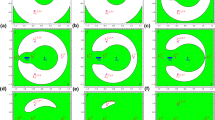Abstract
The paper presents necessary and sufficient conditions whose must be satisfied by the main geometric and dynamic parameters of spherical, ellipsoidal, or parabolic rigid bodies for their physical realization. The main parameters are both the geometric characteristics of the body boundary (radius of the sphere, semiaxes of the ellipsoid, principal curvatures at the vertex, and the paraboloid center location on its symmetry axis) and the body mass and dynamic characteristics (body mass, displacement of the body center of mass from the center on the paraboloid symmetry axis or from the sphere or ellipsoid center of symmetry, the orientation of the principal central axes of inertia with respect to the principal geometric axes of the shell, and the values of the principal central moments of inertia). The physical realization is understood as the existence of an actual distribution of positive masses inside the sphere, ellipsoid, or paraboloid for which the above-listed characteristics of the body are equal to the chosen ones. Several examples from earlier-published papers dealing with the dynamics of spherical, ellipsoidal, or parabolic bodies with physically unrealizable parameters are given.
Similar content being viewed by others
References
K. Magnus, Kreisel. Theorie und Anwendungen (Springer, Berlin, 1971; Mir, Moscow, 1974).
C. M. Braams, “On the Influence of Friction on the Motion of a Top,” Physica 18 (8–9), 503–514 (1952).
E. J. Routh, Dynamics of Systems of Rigid Bodies (Dover Publ., New York, 1955; Nauka, Moscow, 1983).
A. V. Karapetyan and A. S. Kuleshov, “Steady Motions of Nonholonomic Systems,” in Nonholonomic Dynamic Systems. Integrability, Chaos, Strange Attractors, Collected Papers (Inst. Komp’yuter Issled., Moscow–Izhevsk, 2002), pp. 247–295 [in Russian].
A. V. Karapetyan and A. S. Kuleshov, “Methods for Studying Stability and Bifurcation of Steady Motions of Conservative Nonholonomic Systems,” in Problems of Mechanics: Collection of Papers Dedicated to A. Yu. Ishlinskii on the Occasion of His 90th Birth Day (Fizmatlit, Moscow, 2003), pp. 429–464 [in Russian].
A. S. Kuleshov, “To the Top Dynamics on a Rough Surface,” in Problems of Studying Stability and Stabilization of Motion, Collected Papers (VTs RAN, Moscow, 1999), pp. 130–140 [in Russian].
A. V. Borisov and I. S. Mamaev, “Strange Attractors in Dynamics of Celtic Stones,” in Nonholonomic Dynamic Systems. Integrability, Chaos, Strange Attractors, Collected Papers (Inst. Komp’yuter Issled., Moscow–Izhevsk, 2002), pp. 296–320 [in Russian].
R. E. Lindberg and R. W. Longman, “On the Dynamic Behavior of the Wobblestone,” Acta Mechanica 49, 81–94 (1983).
M. K. Chochchi, B. Malengie, B. Langerok, and B. Grimonpre, “To Construction of a Prototype of Spherical Chinese Top,” Nelin. Din. 8 (2), 391–425 (2012).
I. A. Bizyaev, “Nonintegrability and Obstructions to the Hamiltonianization of a Nonholonomic Chaplygin Top,” Dokl. Ross. Akad. Nauk 458 (4), 398–401 (2014) [Dokl. Math. (Engl. Transl.) 90 (2), 631–634 (2014)].
A. V. Borisov, A. O. Kazakov, and I. R. Sataev, “The Reversal and Chaotic Attractor in the Nonholonomic Model of Chaplygin’s Top,” Regular and Chaotic Dynamics 19 (6), 718–733 (2014).
S. O’Brien and J. L. Synge, “The Instability of the Tippe-Top Explained by Sliding Friction,” Proc. Roy. Irish Acad. Sec. A 56 (3), 23–35 (1954).
A. A. Kilin, “The Dynamics of Chaplygin Ball: the Quantitative and Computer Analysis,” Regular and Chaotic Dynamics 6 (3), 291–306 (2001).
A. Yu. Moskvin, “Chaplygin Ball with Gyrostat: Singular Solutions,” Nelin. Din. 5 (3), 345–356 (2009).
A. V. Borisov and I. S. Mamaev, “Obstacle to the Reduction of Nonholonomic Systems to the Hamiltonian Form,” Dokl. Ross. Akad. Nauk 387 (6), 764–766 (2002) [Dokl. Phys. (Engl. Transl.) 47 (12), 892–894 (2002)].
A. V. Borisov, A. A. Kilin, and I. S. Mamaev, “Property of Being Hamiltonian and Integrability of Suslov Problem,” Nelin. Din. 6 (1), 127–142 (2010).
A. Yu. Moskvin, “Rubber Ball on a Plane: Critical Solutions,” Nelin. Din. 6 (2), 345–358 (2010).
Author information
Authors and Affiliations
Corresponding author
Additional information
Original Russian Text © G.M. Rozenblat, 2016, published in Izvestiya Akademii Nauk, Mekhanika Tverdogo Tela, 2016, No. 4, pp. 53–63.
About this article
Cite this article
Rozenblat, G.M. On the choice of physically realizable parameters when studying the dynamics of spherical and ellipsoidal rigid bodies. Mech. Solids 51, 415–423 (2016). https://doi.org/10.3103/S0025654416040051
Received:
Published:
Issue Date:
DOI: https://doi.org/10.3103/S0025654416040051




